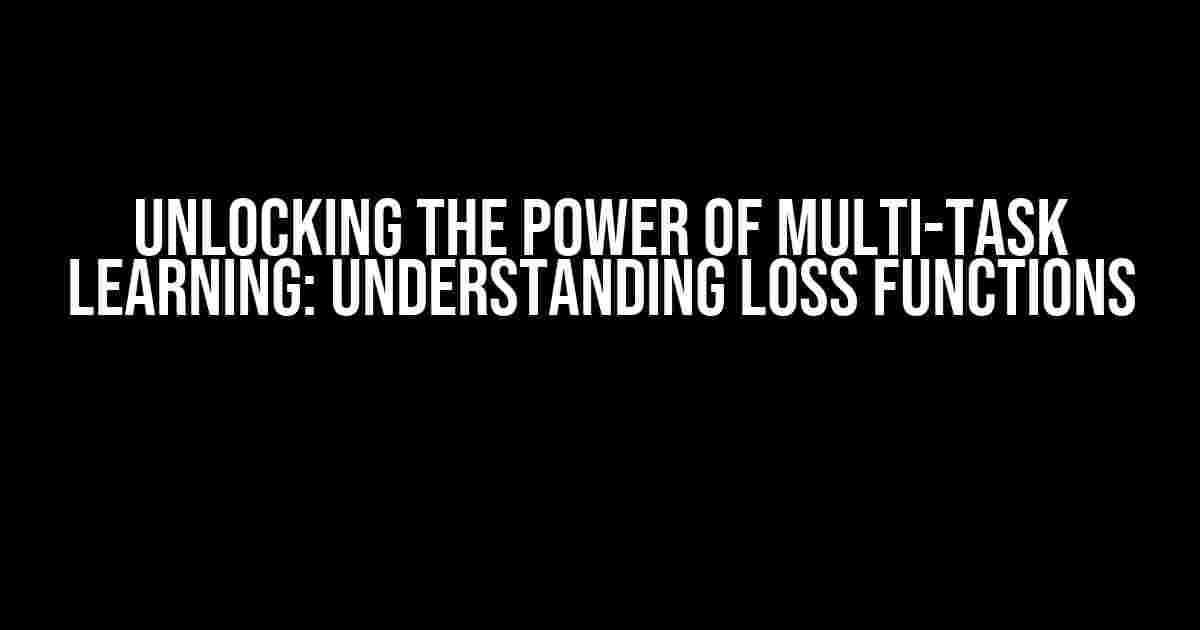If you’re a machine learning enthusiast, you’ve likely come across the term “multi-task learning” and wondered what it’s all about. In this article, we’ll dive deep into the world of multi-task learning, exploring its benefits, types, and most importantly, the role of loss functions in making it all work.
What is Multi-Task Learning?
Multi-task learning (MTL) is a subfield of machine learning that involves training a single model on multiple related tasks simultaneously. The idea is to leverage the shared knowledge and patterns across tasks to improve overall performance. Think of it like a superhero with multiple powers – each power (task) enhances the others, making the superhero (model) stronger and more effective.
Benefits of Multi-Task Learning
- Improved performance**: MTL can lead to better performance on individual tasks by sharing knowledge and features.
- Reduced overfitting**: By training on multiple tasks, the model is less likely to overfit to a single task.
- Increased efficiency**: Training a single model on multiple tasks can be more efficient than training separate models for each task.
Types of Multi-Task Learning
There are several types of MTL, including:
- Hard parameter sharing**: A single model is trained on multiple tasks with shared parameters.
- Soft parameter sharing**: A single model is trained on multiple tasks with separate parameters, but with some shared components.
- Multi-task learning with auxiliary tasks**: A primary task is trained with one or more auxiliary tasks to improve performance.
Loss Functions in Multi-Task Learning
The key to successful MTL lies in defining the right loss function. A loss function measures the difference between the model’s predictions and the true labels. In MTL, we have multiple tasks with their own loss functions.
Type 1: Sum of Task Losses
A simple approach is to sum the loss functions of each task:
loss = ∑(task_loss_i)where task_loss_i is the loss function for task i.
Type 2: Weighted Sum of Task Losses
To give more importance to certain tasks, we can assign weights to each task loss:
loss = ∑(w_i * task_loss_i)where w_i is the weight for task i.
Type 3: Hierarchical Loss Functions
In this approach, we define a hierarchical structure of tasks, where higher-level tasks are composed of lower-level tasks. The loss function is defined recursively:
loss = ∑(task_loss_i) + ∑(hierarchical_task_loss_j)where hierarchical_task_loss_j is the loss function for a higher-level task j.
Implementing Multi-Task Learning in Python
Let’s implement a simple MTL example using Python and the Keras library.
from keras.layers import Input, Dense
from keras.models import Model
# Define the input shape
input_shape = (10,)
# Define the tasks
task1_output = Dense(1, activation='sigmoid', name='task1')(input_layer)
task2_output = Dense(1, activation='sigmoid', name='task2')(input_layer)
# Define the loss functions
task1_loss = 'binary_crossentropy'
task2_loss = 'binary_crossentropy'
# Define the model
model = Model(inputs=input_layer, outputs=[task1_output, task2_output])
# Compile the model with a weighted sum of task losses
model.compile(loss={'task1': task1_loss, 'task2': task2_loss},
loss_weights={'task1': 0.7, 'task2': 0.3},
optimizer='adam', metrics=['accuracy'])
Challenges and Future Directions
While MTL has shown great promise, there are still challenges to be addressed:
- Task conflict**: Tasks may have conflicting objectives, making it difficult to define a suitable loss function.
- Overfitting**: MTL models can still overfit to a single task or a subset of tasks.
- Scalability**: Training MTL models can be computationally expensive and require large datasets.
Future research directions include:
- Developing new loss functions**: Designing loss functions that can handle complex task relationships and conflicting objectives.
- Improving model architecture**: Developing more efficient and scalable MTL architectures.
- Exploring new applications**: Applying MTL to a wider range of domains and tasks.
Conclusion
In this article, we’ve explored the world of multi-task learning, covering its benefits, types, and the role of loss functions. By understanding how to define and implement MTL models, we can unlock the full potential of this powerful machine learning technique.
| MTL Type | Description |
|---|---|
| Hard parameter sharing | A single model is trained on multiple tasks with shared parameters. |
| Soft parameter sharing | A single model is trained on multiple tasks with separate parameters, but with some shared components. |
| Multi-task learning with auxiliary tasks | A primary task is trained with one or more auxiliary tasks to improve performance. |
Remember, the key to successful MTL lies in defining the right loss function and model architecture for your specific problem. Experiment with different approaches, and don’t be afraid to try new things – after all, that’s what machine learning is all about!
Stay tuned for more machine learning tutorials and articles, and don’t forget to subscribe to our newsletter for the latest updates!
About the Author
Alex is a machine learning enthusiast and blogger with a passion for explaining complex concepts in simple terms. When not writing, Alex can be found experimenting with new machine learning techniques or playing chess.
Follow Alex on Twitter: @alex_ml
Frequently Asked Question
Want to master the art of multi-task learning? Start with understanding the loss function, the brain of the operation. Here are the top 5 questions and answers to get you started!
What is a loss function in multi-task learning, and why is it important?
A loss function in multi-task learning is a mathematical function that measures the difference between the model’s predictions and the actual labels. It’s the guiding light that helps the model learn from its mistakes and improve over time. A well-designed loss function is crucial because it directly impacts the model’s performance, and a poor choice can lead to suboptimal results or even catastrophic failures. Think of it as the model’s personal trainer, pushing it to be its best self!
What is the difference between a task-specific loss function and a shared loss function in multi-task learning?
A task-specific loss function is tailored to a particular task and is used to optimize that task alone. On the other hand, a shared loss function is a single loss function that is shared across all tasks. The key benefit of a shared loss function is that it allows the model to learn shared representations and patterns across tasks, which can lead to improved performance and efficiency. Think of it as a team-building exercise, where each task is a team member, and the shared loss function is the coach that helps them work together towards a common goal!
How do I choose the right weights for each task in a multi-task learning setup?
Choosing the right weights for each task is a crucial step in multi-task learning. One popular approach is to use uniform weights, where each task is given equal importance. However, this might not always be the best strategy, especially when tasks have varying difficulties or importance. A more effective approach is to use task-dependent weights, which can be learned during training using methods like uncertainty-based weighting or gradient normalization. Think of it as finding the perfect recipe, where each task is an ingredient, and the weights are the secret sauce that brings them all together!
Can I use different loss functions for different tasks in a multi-task learning setup?
Absolutely! In fact, using different loss functions for different tasks can be beneficial when tasks have distinct characteristics or requirements. For example, you might use a mean squared error (MSE) loss function for a regression task and a cross-entropy loss function for a classification task. This approach allows each task to optimize its own objective function, which can lead to better performance. Think of it as having a specialized toolbox, where each task has its own tailor-made tool that helps it shine!
How do I handle conflicting objectives in a multi-task learning setup?
Conflicting objectives can occur when tasks have competing goals or requirements. To handle this, you can use techniques like multi-objective optimization, which involves finding a balance between the competing objectives. Another approach is to use regularization methods, such as L1 or L2 regularization, to penalize tasks that dominate the others. Think of it as finding a delicate balance, where each task is a delicate flower, and the goal is to nurture them all to bloom in harmony!



